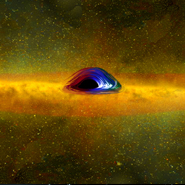Posted 01 October 2010
ESA space satellite results presented at UCD hosted conference
The Minister for Science, Technology & Innovation, Mr Conor Lenihan TD officially opened the INTEGRAL international conference in Dublin Castle on Monday 27 September 2010. He outlined how Ireland’s membership of the European Space Agency (ESA) plays an important role in our efforts to succeed as a knowledge economy.
At the UCD hosted conference, the Minister highlighted the important contribution of Irish scientists and companies to the work of the European Space Agency, commenting that: “Ireland’s membership of the European Space Agency provides excellent opportunities for commercialisation of research outputs and in the last ten years has assisted over 50 Irish companies to secure ESA contracts worth over €60M.”
Pictured far right: Artist's impression of accretion material around a black hole - (image courtesy of ESA)
Minister Lenihan added, “The Government’s strategy, as implemented by Enterprise Ireland has encouraged a growing number of high technology companies emerging in this sector and developed a strong reputation in Europe for bringing highly advanced and innovative technologies to the space programme.”
For the past eight years, as part of the European Space Agency’s (ESA) Horizon 2000 Science Programme, INTEGRAL (the International Gamma-Ray Astrophysics Laboratory) has conducted scientific observations of the Universe from an orbit more than 60,000km above the Earth. It is the first space observatory that can simultaneously observe objects in gamma rays, X-rays, and visible light.
Over the course of the conference from 27 – 30 September, delegates were presented with the latest data from INTEGRAL.
“The catalogue of information produced by the European Space Agency (ESA) satellite provides insights into the most violent and exotic objects in the Universe: black holes, neutron stars, supernovae and active galactic nuclei (AGNs); located at distances approximately 652 to 980 million light-years away from Earth,” says Professor Lorraine Hanlon, UCD School of Physics, University College Dublin.
Ireland has been a member of the ESA since 1975. The Irish companies that have secured contracts with the ESA represent a range of industrial sectors including: ICT, materials, engineering, electronics, and optoelectronics. By developing technologies through ESA programmes, Irish industry can leverage direct commercial sales in aerospace and other worldwide markets.
XMM-Newton, an ESA earth orbiting satellite observatory, on public display at UCD Science
Professor David Southwood, Director of the European Space Agency (ESA) Science and Robotic Exploration Programme, observes a 1:4 scale model of XMM-Newton, an ESA earth orbiting satellite observatory, donated to University College Dublin. The model is now on public display in the UCD Science Building, Belfield.
XMM-Newton is designed to observe high-energy X-rays emitted from exotic astronomical objects such as pulsars, black holes and active galaxies. On its orbit, the satellite travels out to nearly one third of the distance to the Moon enabling it to conduct very long and uninterrupted observations. Its wafer-thin X-ray mirrors are a miracle of engineering and the smoothest ever built.
(Produced by UCD University Relations)

